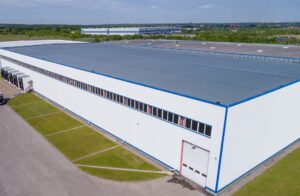Why the Right Sealant Makes the Difference in Long-Term Performance and Weatherproofing in Metal Buildings
by David Flaherty | 29 July 2025 12:54 pm
 [1]
[1]In the construction of modern metal buildings, long-term performance hinges on more than just the structural design—it depends on what seals everything together. While often overlooked, non-skinning sealants are critical in maintaining weather-tightness, energy efficiency, and durability, particularly in insulated metal panels (IMPs) and standing seam roof (SSR) systems.
Key challenges in metal building construction
Metal buildings are designed for strength, efficiency, and longevity; however, achieving those outcomes requires more than precise installation—it demands the right sealing solutions to combat:
- Thermal movement, which causes panels to expand and contract
- Moisture infiltration through laps, joints, and penetrations
- Air leakage, reducing insulation effectiveness and increasing energy costs
- Exposure to harsh environments, including UV, wind, and temperature swings
These challenges make the selection of high-performance sealants critical to ensure a weather-tight building envelope and protect structural integrity over the building’s lifespan.
The role of sealants in metal installation applications
Sealants are widely trusted in metal building systems for their strong adhesion, long-term flexibility, and resistance to the elements. Unlike traditional caulks or hardening sealants, butyl-based and non-skinning sealants maintain performance without cracking or drying out over time. They provide a consistent, long-lasting barrier against moisture and air infiltration, which is critical in factory-assembled and field-installed systems.
What happens when the proper sealant isn’t used
Using the wrong sealant—or skipping sealant altogether—can lead to:
- Water penetration and corrosion
- Loss of thermal performance
- Premature material degradation
- Increased maintenance and repair costs
- Voided warranties and failed inspections
Types of Sealants & Their Application Areas
Metal building sealants generally fall into two categories: butyl tape sealants and non-skinning sealants, each suited to specific needs in metal construction.
Butyl tape or non-skinning sealants: What’s the difference?
| Feature | Butyl Tape Sealants | Non-Skinning Sealants |
| Application Areas | Rib joints, end laps, roof curbs, and skylights | Panel joints, concealed seams, and roll-forming joints |
| Form | Pre-formed tape rolls | Fluid sealant (packaging options: caulk tube, sausage pack, pail, or drum) |
| Installation | Peel-and-stick; tool-free | Requires gunning or pumping |
| Movement Tolerance | Moderate – conforms to the surface | High – ideal for dynamic joints |
| Repositioning Ability | Limited after initial application | Easily repositionable during installation |
| Mess/Cleanup | Clean, minimal residue | Clean application; no stringing or webbing |
| Priming Required | No priming required | No priming required |
| Best For | Simple joints, exterior sealing, and easy installs | High-movement areas, factory/field panel joints |
| Flexibility | Maintains shape; flexible | Non-hardening and fully flexible over time |
| Appearance | Hidden between joined surfaces | Hidden within seams or panels |
Butyl tape sealants are ideal for sealing metal rib and end joints, standing seam roof end laps, and around roof curbs, jacks, and skylights. They are highly tacky, adhere to common metal coatings like Kynar, Galvalume, and Zincalume, and apply easily without tools—even in temperatures from -5°F to 120°F. Permanently flexible and UV/weather-resistant, butyl tapes will not crack or flow under stress. With an 18-month shelf life and various sizes, they’re a proven, reliable choice across metal building types.

Non-skinning sealants are designed for more dynamic applications, such as IMP joints, standing seam concealed seams, and roll-forming lines. Their non-hardening formula stays flexible over time and allows repositioning during installation. Easy to apply with no priming or cleanup required, they bond well to clean surfaces and adapt to joint movement from thermal expansion. Available in tubes, pails, or drums, they offer clean, efficient sealing for factory and field use.

Conclusion
Choosing the proper sealant is essential for protecting a metal building from the start. With proven performance, flexibility, and weather resistance, butyl-based sealants—tape and non-skinning varieties—are critical tools in the contractor’s arsenal. Whether sealing a cold storage facility or installing a standing seam roof, using the correct product ensures fewer callbacks, lower lifecycle costs, and higher customer satisfaction.
 [2]Quenton Roehricht is a product manager at Amrize Building Envelope, bringing over 20 years of experience in the building materials industry. With a strong background in marketing and product management, he has spent the past two years leading the adhesives and sealants category for the Gaco brand. His portfolio includes GacoBond, GacoSeal, American Safety Technologies, and Tacky Tape, where he drives product strategy and innovation.
[2]Quenton Roehricht is a product manager at Amrize Building Envelope, bringing over 20 years of experience in the building materials industry. With a strong background in marketing and product management, he has spent the past two years leading the adhesives and sealants category for the Gaco brand. His portfolio includes GacoBond, GacoSeal, American Safety Technologies, and Tacky Tape, where he drives product strategy and innovation.
- [Image]: https://www.metalconstructionnews.com/wp-content/uploads/2025/07/AdobeStock_242630875_resize.jpeg
- [Image]: https://www.metalconstructionnews.com/wp-content/uploads/2025/07/Quenton-Roehricht-headshot.jpg
Source URL: https://www.metalconstructionnews.com/articles/the-right-sealants-for-metal-buildings/